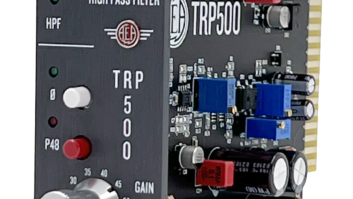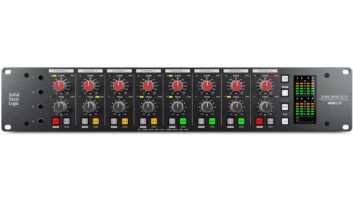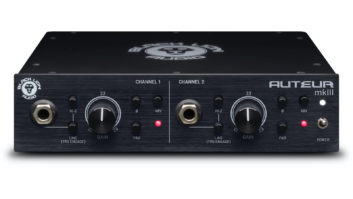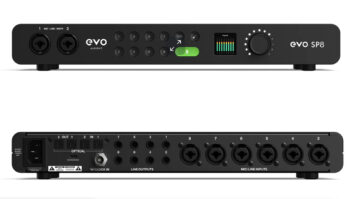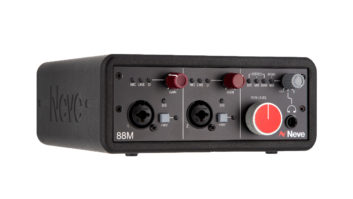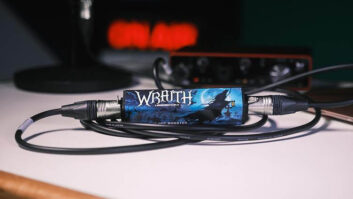The 2-channel RTZ 9762 is a single-rackspace remake of the Class-A Neve 1272 microphone preamp. The 9762 adds to the original’s operation and sonics with modern features and circuit refinements. The unit’s 17-pound heft and “no-frills” front panel clearly indicate a greater emphasis on manufacture quality.
ON THE INSIDE
Inside the reinforced all-steel cabinet is a separate steel compartment shielding the power supply’s toroidal transformer from the two preamp PC boards. In addition, mu-metal foil surrounds the power transformer and both 9160 Sowter output transformers for additional control of stray 60Hz magnetic fields.
Both preamp channel boards have +24-volt rail voltage regulators and filtering, and independent auto-resettable thermal-overload fuses with front panel indicators.
ON THE FRONT
The front panel has a gold-contacted Grayhill 12-position mic gain rotary switch for 20 to 75 dB in 5dB steps. Like most Neve module conversions, there is a line amp output level control. Here, a heavily damped Clarostat 308 Series pot sets final output level with the 9762 capable of a 40V peak-to-peak before clipping. An internal jumper sets the line amplifier gain to either 15 or 10 dB, the factory default.
Other features include a signal-present LED that lights green when a 200mV or -20dB ref 0.775V signal is on the input and responsive LED output VU meters for each channel with +6, +3, 0, -5 and -10dB indicators. There is also an overload LED when any clipping occurs within the input stages. In my use, I was unable to clip the 9762’s front end because it will take up to 0 dBu without attenuation.
The unit also features polarity flip and +48V phantom powering that ramps up and down when switched on/off. A lo-Z switch parallels the Lundahl LL 1538 transformer’s input primary windings for 50-ohm input impedance when pushed; releasing the switch returns impedance to 200 ohms. Term switches a termination resistor (an internal jumper allows a choice of a 600- or 1.5k-ohm resistor) across the Sowter’s output winding (more later) and a ¼-inch hi-Z input jack for direct recording.
When the DI button is pushed, a FET buffer stage bypasses the input transformer and acts as an impedance converter. With the input impedance now at 10 megohms, there is no chance of loading a guitar/bass pickup or a sensitive piezo unit and changing its sound. Another pair of FETs with the relays provide a wonderful output muting feature. Not in the audio path, these are shunt switches that short the output signal to ground during any DI/mic or impedance-switching operations.
IN THE STUDIO
I started my evaluation with vocal overdubs using a Neumann U87A (no pad, no roll-off, cardioid pattern) and a Pro Tools MIXPlus system. I compared the 9762 to a Brent Averill Neve 1272 conversion. With the termination resistor switched on the RTZ’s output, I got the flattest frequency response and the closest Neve match. The 9762 was quieter with no hum and had a very slightly more open high end. I also noticed better subsonics — even on vocals. This particular Neve was warmer in the low midrange with my singer’s “p” pops more noticeable.
Switching the termination off opened up the sound of the 9762’s high end for more “air” — you could hear more ambience around the singer’s voice. The Neve conversion sounded nasal by comparison. Trying the RTZ’s 50-ohm input impedance momentarily muted the output and caused the level to come up. I liked the “fade up/down” phantom-powering feature — it worked perfectly. I also used the DI switch as a silent mic mute switch — if nothing is plugged into the DI input.
Next up were drum overdubs. I recorded into Pro Tools|HD and used a vintage ’70s API console for all of the close mics and the 9762 for overheads. With the termination off, I found the overhead mics (wide-spaced B&K/DPA 4011 cardioids about 1 meter above the toms) to sound more open than the stock API channels. I could hear more of the whole kit and the room, and there was loads of gain. I used 20 dB of gain.
The DI input worked well for a Fender P-Bass with passive pickups. This path is just like a very expensive FET DI box you would need to add to any Neve unit. Again resulting in better subsonics, I attribute that to the better-quality transformers in the 9762 than a Neve.
PROMISES KEPT
The RTZ 9762 fulfills the promise of the ultimate vintage Neve sound. It’s an excellent rethinking of the original Rupert Neve design, realized in a modern, bulletproof professional product. The operational shortcomings that occur when converting a vintage ’60s console module to stand-alone operation were addressed, while the sound we all love stays essentially the same. Price: $1,495.
RTZ Professional Audio (www.rtzaudio.com), dist. by Atlanta Pro Audio, 404/329-9494, www.atlantaproaudio.net.
Barry Rudolph is an L.A.-based recording engineer.
